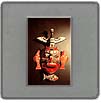 |
|
A n I n t r o d u c t i o n t o |
|

|
R i c h a r d
H u n t b. 1951, Alert
Bay, British Columbia Website: http://www.richardhunt.com Richard Hunt, along with his brother Tony, is the descendant of a long line of significant and respected artists, including grandfather Mungo Martin, and George Hunt, a critical source of knowledge for anthropologist Franz Boas. A carver and painter, Hunt was taught carving by his father Henry, and studied jewelry-making at Camosun College, Victoria, British Columbia. The artist is noted for not hybridizing his art with the forms of other nations, preferring to preserve the traditional forms of his heritage, the expression of which he feels is an act of reclamation. Experienced in rituals and performances for potlatches and feasts, he is also a dancer of the highest ranking. Hunt has carried out many commissions, including the chief carving for the Royal British Columbia Museum's Thunderbird park, and was honoured with the Order of British Columbia (1991) and the Order of Canada (1994).
R E C E N T E X H I B I T I O N S
American Federation of Arts, New York S E L E C T E D B I B L I O G R A P H Y "Artist ambassador for First Nations." Kahtou 7, no.18 (18 September 1989): 12. Campbell, Leslie. "Richard Hunt: Renowned Native carver." Focus on Women 5, no. 9 (June 1993): 52-54. Holm, Denise. "Native dozen collaborate on furniture art for U.Vic." Victoria Times-Colonist, 26 October 1993, p. B1. Raab, Diana. "Unconquered Pride visits Minneapolis (Objects of Bright Pride: Minneapolis Institute of Arts)." Kahtou 6, no. 13 (4 July 1988): 9. Steltzer, Ulli. Indian Artists at Work. Vancouver, British Columbia: J. J. Douglas, 1976. Stewart, Hillary. Looking at Indian Art of the Northwest Coast. Seattle, Washington: University of Washington Press, 1979.
|
|||||||||||||||||||||||||
| <Previous - Next> |